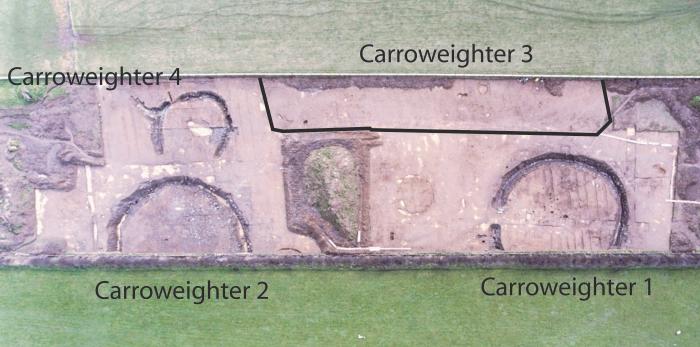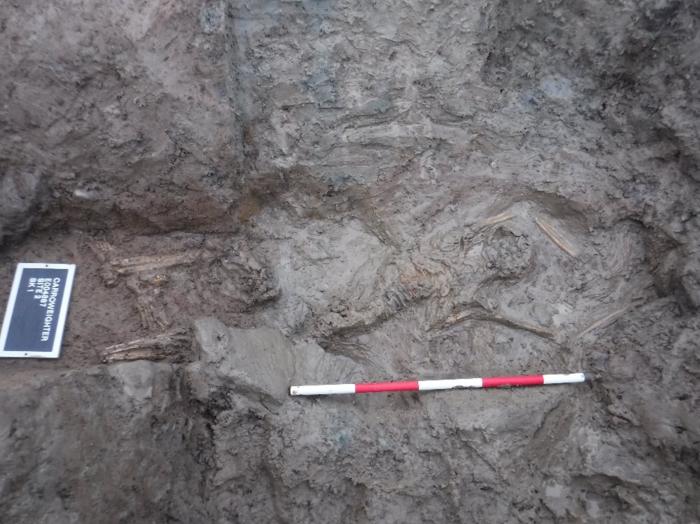Prehistoric Occupation and Ritual at Carroweighter, Co. Roscommon
By Shane Delaney of IAC Archaeology
Bronze Age pottery and cremation burials, evidence for Iron Age light industrial activity, and the remains of a mutilated adult male were among the finds made during the excavation of enclosures and related features in the townland of Carroweighter, Co. Roscommon.
Four sites were identified through geophysical survey in the townland in 2011; these were excavated between September 2017 and March 2018 by IAC Archaeology (IAC) on behalf of Roscommon County Council and TII as part of the N60 Oran Road Realignment Project. The sites were located on the crest of a low hill in a sparsely populated rural landscape characterised by open farmland. This landscape is home to a number of recorded archaeological monuments; some of these are prehistoric, but the majority are associated with ecclesiastical activity in the first millennium AD. The Carroweighter sites represent a microcosm of this activity, illustrating—as they do—continuity of occupation from the Bronze Age, through the Iron Age and into the early medieval period.

Aerial view of Carroweighter 1–4 under excavation in the middle foreground, with the Oran ecclesiastical site (enclosed by a line of mature trees) at top right (looking south) (Photo: IAC Archaeology).
Carroweighter 1–4 comprise two closely spaced clusters of features; Sites 1 and 3 near the western limit of the excavated area, and Sites 2 and 4 towards the eastern limit. The sites take the form of substantial penannular enclosures with groups of smaller cut features—such as pits, kilns, stake-holes, post-holes, and foundation cuttings—at both their interiors and exteriors.
Carroweighter 1 and 3
The most prominent feature comprising Carroweighter 1 (Sites and Monuments Record No. RO034-112001) was a 28 m-diameter ditched enclosure with a causewayed entrance on its eastern side. The entrance was flanked with internal post-holes and stake-holes that represented a gated access to the site. The earliest element of the Carroweighter 1 site was a Late Bronze Age cremation burial of at least two individuals (skull fragments from one of these returned a radiocarbon date of 1191–924 BC) at the centre of the enclosure. The radiocarbon date ranges (8th to 5th century BC) from finds from the lower to middle deposits within enclosure ditch are significantly later than those from the cremation; construction of the enclosure around the pre-existing cremation burial is a possibility, though more likely is the insertion of the cremated human remains at the centre of the enclosure during construction as part of a carefully curated foundation deposit.

Clockwise from top left: Carroweighter 4, Carroweighter 3, Carroweighter 1 and Carroweighter 2 (Photo: IAC Archaeology).
The enclosure ditch at Carroweighter 1 produced 99% of all animal bone from the site. A fragment from the middle fill of the ditch returned an Early Iron Age date (795–543 BC) and it appears that the enclosure ditch was being used as a dump shortly after construction. Other finds from the ditch cut included sherds of Middle to Late Bronze Age domestic pottery, chert, rhyolite, flint, quartz and a hone stone (a Neolithic polished dolerite axehead from an upper fill is considered intrusive).
Two structures were recorded at the interior of the enclosure: a stake- and post-built roundhouse, with a porch oriented on the enclosure entrance, and a rectangular four-post structure to its immediate east. The house was roughly 5 m in diameter and was dated to 787–490 BC. Pits, as well as stake- and post-holes probably representing internal divisions and roof supports, were recorded within the house, though no hearth was identified. The four-post structure likely represents the remains of a support structure erected over a shallow, sub-circular pit. This may have been used for food processing or cooking, or may have functioned as a granary platform.
Some 14 m east of the enclosure lay the foundation trench for an 8 m-diameter roundhouse. Although not scientifically dated, the roundhouse produced artefacts similar to those from the enclosure ditch, including Late Bronze Age domestic pottery and a hone stone, and is likely contemporaneous.
Carroweighter 3 (RO034-112003) lay immediately south of the Carroweighter 1 enclosure and was a much less well-defined site. It consisted of the remains of two kilns, 33 pits, eight stake-holes and two post-holes dispersed across an area measuring some 85 m (east–west) by 12 m. Radiocarbon dates indicate that activity in this area south of the enclosure extended from the Middle Bronze Age (one of the pits returned a date of 1407–1233 BC) through the Iron Age (another pit with associated stake- and post-holes was dated to 412–257 BC) and into the early medieval period (one of the kilns returned a date of AD 409–540).
Carroweighter 2 and 4
Though initially excavated and recorded as separate sites, Carroweighter 2 (RO034-112002) and Carroweighter 4 (RO034-112004) were quickly recognised as being closely related. As was the case at Carroweighter 1, excavations at these two sites revealed activity ranging in date from the Middle Bronze Age through to the Late Iron Age.
Carroweighter 2 took the form of a large circular enclosure ditch, with an internal diameter of 24.5 m, some 50% of which extended northwards and outside the area of excavation. This feature may represent the remains of a barrow. Carroweighter 4 lay to its immediate south and consisted of a substantial Middle Bronze Age enclosure which was heavily truncated by a recut and related activity during the Iron Age. This Middle Bronze Age activity—falling in the date range 1740–1535 BC—represents the earliest activity at these two sites. Slightly later—from the Middle to Late Bronze Age, 1393–1135 BC—was the partial arc of a probable structure defined by a shallow sub-circular cut feature (to the west of the Carroweighter 2 enclosure) that may represent a roundhouse similar to that found to the east of Carroweighter 1.
During the period 738–392 BC, a single adult of undetermined sex was cremated, and a token quantity of the bone was buried in a pit. This cremation pit formed the focus for the construction of the large circular enclosure ditch which—by 354–108 BC—comprised the most extensive feature at Carroweighter 2. As well as animal bone, the unburnt, mutilated body of an adult male (360–114 BC) had been unceremoniously dumped at the base of this cut. Analysis of isotopes from his teeth and bone revealed that he was not native to the region, having travelled there as an older child from the east of Ireland or perhaps Britain. The manner of his death, including the severance of his right foot at or near the time of death, and the irreverent dumping of his body in the open ditch indicates punitive treatment, perhaps for some perceived social or political transgression.
No bank survived at Carroweighter 2, though the Iron Age phase at Carroweighter 4 (to its immediate south) respected the line of its ditch, with a buffer of c. 5 m at its exterior. This suggests the former existence of an external bank at Carroweighter 2. The Carroweighter 2 ditch cut was entirely backfilled by the second or third centuries AD, and no evidence for later activity at these sites was recorded.

The adult male burial in the ditch at Carroweighter 2 (Photo: IAC Archaeology).
Activity at the Carroweighter sites spanned a considerable period of time. Bronze Age domestic occupation was recorded at Carroweighter 1, 2 and 4, and what appears to have been ritual activity was dated to a relatively short period of time in the Iron Age at Carroweighter 2 and 4. The possibility that the two enclosures, albeit of different dates, were focussed on founder cremation burials suggests continuity of ancestral ties at a local gathering place (perhaps an early precursor of an ancestral assembly place known in Irish as an óenach). Through the establishment of the ecclesiastical community at Oran (RO034-080)—only 150 m to the south of these sites—the Church may have sought to appropriate some of their associated prestige. Unfortunately, little is known of this early monastic complex. The early medieval church site developed around a holy well (RO034-080010) which has associations with both St Patrick and Lughnasa. The site is known as Uran Garadh (Uarán nGarad), as well as Uran O’Clabaigh, or ‘the well of O’Claggy’. This church site (RO034-080001) is part of a cluster of early ecclesiastical remains—including a graveyard (RO034-080002), a round tower (RO034-080003) and two earthworks (RO034-080005 and RO034-080014)—which were destroyed with the expansion of the modern graveyard. The area is rich in early medieval and medieval settlement sites, indicating that Carroweighter continued to be a focus of occupation and activity throughout these periods.
More information on the archaeological features and artefacts found on the scheme are described in the final excavation report for each site and can be accessed in the TII Digital Heritage Collections.
Further reading
Tobin, M, McIlreavy, D, Moore, J and Montgomery, J 2022 ‘Punishment in the Iron Age? A case study from Carroweighter, Co. Roscommon’, The Journal of Irish Archaeology, Vol. XXXI, 7–26.
(Posted 15 May 2023)